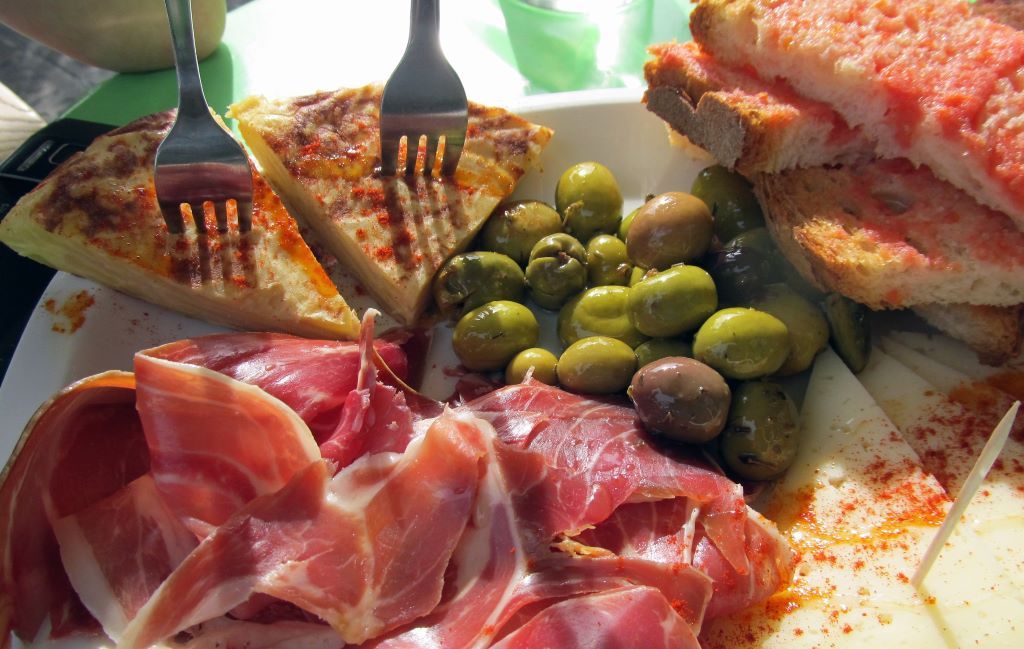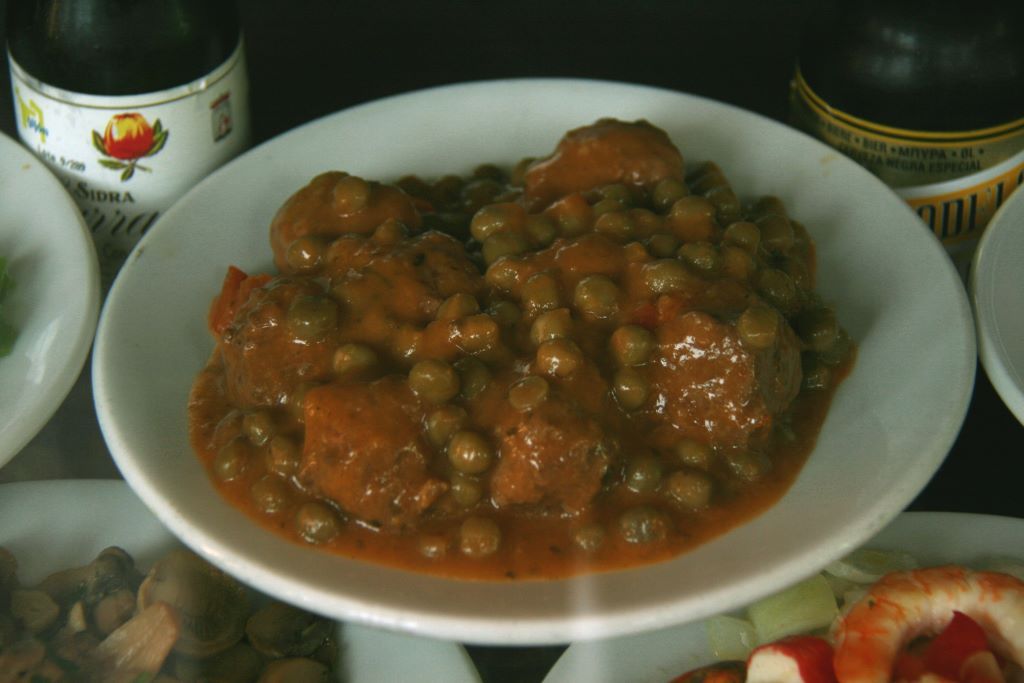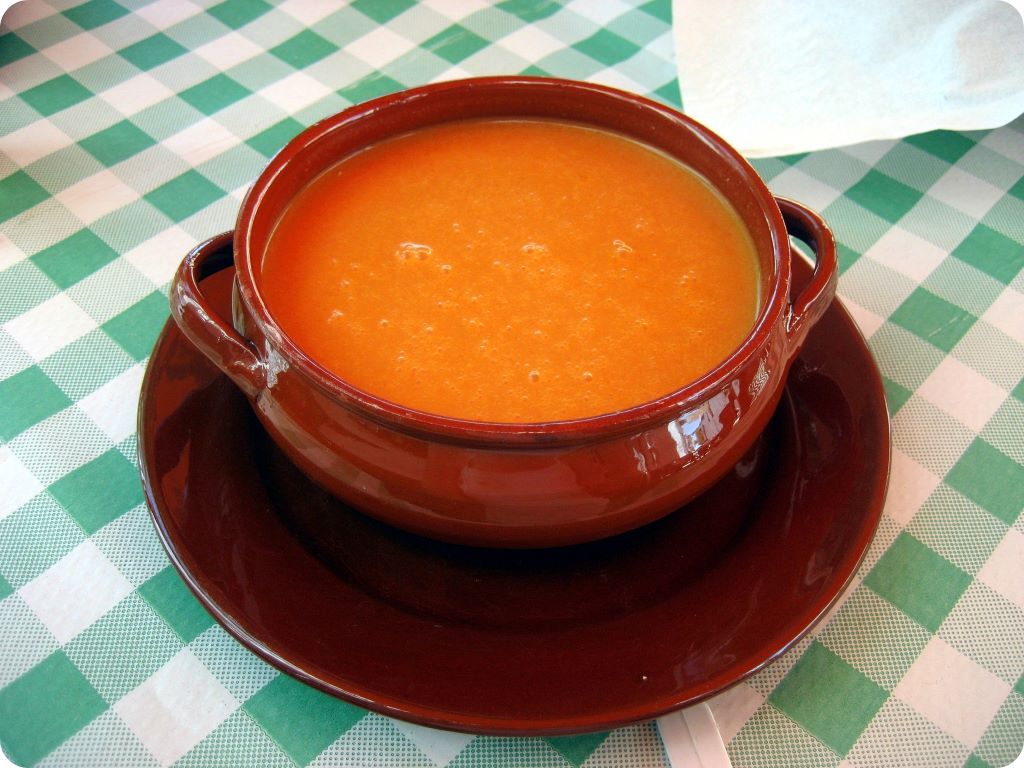

There are some destinations that are synonymous with adventure, some that invite you to lose yourself in nature, and some that are all about art and architecture. And then there are the places you go just because you’re feeling really hungry. As far as we’re concerned, Spain is one of the best foodie destinations around. Loosen your belt and grab your napkin because it’s time to discover what to eat in Spain.
Top tapas to try
Before we start, let’s clear up a few of the most common misconceptions about tapas. It’s a simple concept, but one which often gets misinterpreted in other countries. First of all, it’s time to remove the phrase ‘tapas bar’ from your vocabulary. When it comes to Spain food, there’s simply no such thing as a tapas bar. In fact, all bars serve tapas. Also, they’re not designed to be a meal, either. Instead, tapas are small bar snacks designed to accompany your glass of beer or tinto de verano.
Secondly, tapas aren’t exactly designed for sharing. By definition, a tapa is a very small portion. The name tapa means lid and Spanish legend suggests that these snacks were originally invented to literally sit on top of your glass or bottle, keeping the flies out of your beer. If you want to share, order a ración, which is a larger portion.
Make sure you use the local lingo — they’re tapas in most of the country, but not everywhere. When is a tapa not a tapa? When it’s a pintxo. This term is commonly used in the Basque Country and neighbouring northern provinces like Cantabria. Using the right term is a great way to impress the locals, so be sure to ask the barman for pintxos if you’re in Bilbao or San Sebastián!
Finally, it’s worth noting that in many parts of the country, tapas are free. That’s true in southern areas like Granada and Álmeria, as well as in the northern provinces of Lugo and León. Be aware that when a tapa is free, you may not have any choice over what the barman brings you, but who’s complaining? Here are a few of our favourite tapas:
Patatas bravas
Top of the list of what to eat in Spain, we’re going for bravas. These are chunky potato wedges served with a mildly spicy sauce. They’re a fabulously moreish Spanish take on chips, and many bars pride themselves on their unique bravas sauce recipe.
Some bars serve their patatas with two sauces: bravas and aioli. This is a rich, garlicky mayonnaise that’s heavy on the garlic. You might not want to kiss anyone after indulging in this sauce, but we can’t deny that it tastes great!
Gambas al ajillo
Speaking of Spain dishes that aren’t suitable for dates…garlic lovers really can’t miss this delicious tapa, one of our favourite Spain cuisine dishes. It consists of prawns in garlic-infused olive oil, and it’s usually served still sizzling.
Enjoy your gambas al ajillo with crusty Galician bread that you can dunk into the oil, scooping up the slivers of garlic. You may also find a couple of tiny dried chillies lurking in the oil. Be warned — they’re far spicier than most dishes in Spain!

Chipirones
The Spanish love their seafood. If you’re a fan of everything that comes from the sea, you’ll probably never find yourself wondering what to eat in Spain! While calamari rings are quite common, we prefer these delicate morsels of tiny baby octopus, usually served lightly battered and deep-fried.
Chipirones go well with a simple squeeze of lemon over the top, or you might want to try them with some aioli for dunking. You’ll find them all over the country, but it’s particularly hard to beat them when you’re sitting at a bar with a sea view.

Albóndigas en salsa
They may sound wonderfully exotic, but albóndigas are just the Spanish word for meatballs. They’re traditionally served with a rich, meaty sauce. Make sure you have some bread to soak it up.
These meatballs are one of the most popular meaty tapas around and a favourite in traditional bars around the country. Enjoy them with a glass of red wine and, if you can, someone playing flamenco guitar in the background!

Croquetas
Don’t be fooled! Spanish croquetas may look like the humble potato croquette, but they’re very different. In fact, there are usually no potatoes involved at all. Instead, the inside is made of a meltingly soft bechamel sauce flavoured with all kinds of delightful ingredients. At home, a Spanish abuela might make croquetas with the leftover meat from Sunday lunch, but in a bar, they’re one of the most popular tapas of all.
Croquetas de jamón (ham) and croquetas de pollo (chicken) are perhaps the most common varieties, but these days, chefs let their imaginations run wild. We love squid croquetas with a dramatic jet-black interior, thanks to the ink. You can also try croquetas made with morcilla, the Spanish version of black pudding. Some truly out-there bars have even experimented with dessert croquetas, which are definitely an acquired taste!

What to eat in Spain for breakfast
Unfortunately, you can’t have tapas first thing in the morning — believe us, we’ve tried to convince plenty of waiters! Luckily, the Spanish also have some great breakfast dishes. Here are a few of our faves.
Tortilla de patatas
Tortilla de patatas, the famous Spanish omelette, is enjoyed at all times of the day, but we particularly like it in the morning. Don’t expect anything fancy, as this is a fundamentally rustic dish made with just three ingredients: potatoes, eggs and olive oil. The question of whether or not to include onion is the biggest national debate in Spain, even more contentious than Real Madrid vs Barça!
Tortilla is traditionally served runny in the middle, so waiters will usually bring you some bread to have with it. With a nice cup of coffee, it’s the perfect way to start the day.

Pa amb tomàquet
This dish is commonly known by its Catalan name, but if you want to order it in Spanish, ask for pan con tomate. Either way, it’s bread with tomato, which may sound a bit uninspiring, but we promise — it’s so much more than the sum of its parts! You can also ask for some jamón to drape over the top for a more substantial breakfast.

In Barcelona and the surrounding region of Catalonia, your pa amb tomàquet will traditionally be served in a DIY way. You’ll get a hunk of toasted bread, a clove of garlic, a tomato and that all-important olive oil. Rub the garlic over the bread, then smash the tomato on top of that. Drizzle over some oil, and you’re ready to go! Very ripe tomatoes only, please.
Churros con chocolate
Ask anyone with a sweet tooth what to eat in Spain, and there’s only one answer! Churros may not be the most waistline-friendly choice, but they make a great special breakfast. They are essentially deep-fried, fluted doughnuts, usually served with a generous topping of sugar.
Order a mug of chocolate for dipping your churros. If you’ve never tried Spanish hot chocolate, you’ll soon see that it’s much thicker than in other countries, making it impossible to drink straight, but it is perfect as a dunking liquid. On a cold day, this breakfast is hard to beat!
Gazpacho
Cold tomato soup for breakfast? Yes, really! It may be easier to understand if you realise that for Spanish people, gazpacho is not really a soup —it’s more of a refreshing drink. Having a glass of it alongside your morning tostada is just like having a glass of orange juice.
A bowl of gazpacho is more common at other times of the day, but at breakfast, it’s always served in a glass. Make sure to drink it cold. If you don’t have much of a sweet tooth, this is a great way to get a hefty dose of good-for-you vitamins first thing in the morning!

Classic dishes in Spain to try
Finally, here are a few of our all-time favourites. Remember, in Spain, lunch is the main meal of the day — and eating before 2 pm will mark you out as a tourist. In fact, most eateries won’t even serve you if you come too early!
Paella
No list of what to eat in Spain would be complete without this classic, but there are a few caveats. First of all, the Spanish definitely don’t regard paella as their national dish. It comes specifically from the rice-growing region of Valencia, where it is considered sacred. In the rest of the country, it’s not such a popular choice.
You might also be surprised by the ingredients of a paella. The traditional paella valenciana has no seafood, instead using chicken and rabbit. Most restaurants now offer some kind of seafood paella, but mixing chicken and seafood is a definite no-no for the Spanish. Finally, don’t even think about asking for chorizo in your paella! That’s considered an act of cultural barbarism that might well be seen as a declaration of war.
Pulpo a feira
Galicia, in the northwest of Spain, is known for its seafood — and top of this list is this simple but delicious octopus dish. The octopus is served with boiled potatoes and dusted with paprika. You can enjoy it as a tapa, but we think it’s special enough to have its own place on our list.
To enjoy this in the traditional way, forget the fork. Instead, locals pick up slices of octopus with a wooden toothpick that matches the special wooden boards the dish is served on. For a truly authentic Galician experience, pair your octopus with a bowl — yes, that’s right, a bowl — of albariño wine. Glasses are for tourists!
Calçots
This Catalan dish is only available in the winter when calçots — a slightly sweet, long green onion — are in season. It’s extremely popular in Catalonia but unheard of in the rest of the country. During the all-too-brief calçot season, Catalans enjoy calçotades, which are a special kind of barbecue. There’s usually some sausage and other meat available, but the grilled calçots are the main attraction.
To eat them like a local, peel off the burned outer layer and dip your calçot in a jar of romesco sauce. Then tip your head back, hold it high above your mouth, and carefully lower it in whole! You might need a bit of practice to get the technique down, but we promise it’s worth it.

All that is just a taster of what to eat in Spain! If you’d like to join us for a gastronomic voyage that you’ll never forget, why not come along on our trip to Barcelona and the Costa Brava? We’ll be sampling some of the best local cuisine as we explore this magical part of the country. Throw away the scales and come along!



